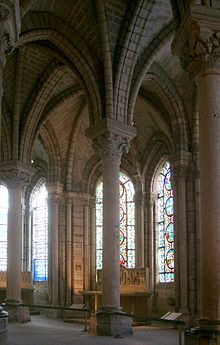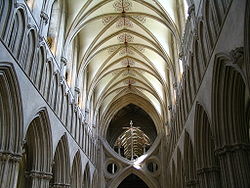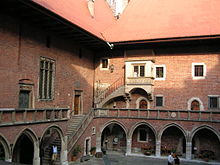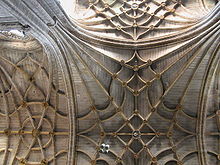- Gothic architecture
-
See also: Gothic art
 The western façade of Reims Cathedral, France.
The western façade of Reims Cathedral, France.
Gothic architecture is a style of architecture that flourished during the high and late medieval period. It evolved from Romanesque architecture and was succeeded by Renaissance architecture.
Originating in 12th century France and lasting into the 16th century, Gothic architecture was known during the period as "the French Style," (Opus Francigenum), with the term Gothic first appearing during the latter part of the Renaissance. Its characteristic features include the pointed arch, the ribbed vault and the flying buttress.
Gothic architecture is most familiar as the architecture of many of the great cathedrals, abbeys and churches of Europe. It is also the architecture of many castles, palaces, town halls, guild halls, universities and to a less prominent extent, private dwellings.
It is in the great churches and cathedrals and in a number of civic buildings that the Gothic style was expressed most powerfully, its characteristics lending themselves to appeal to the emotions. A great number of ecclesiastical buildings remain from this period, of which even the smallest are often structures of architectural distinction while many of the larger churches are considered priceless works of art and are listed with UNESCO as World Heritage Sites. For this reason a study of Gothic architecture is largely a study of cathedrals and churches.
A series of Gothic revivals began in mid-18th century England, spread through 19th-century Europe and continued, largely for ecclesiastical and university structures, into the 20th century.
Contents
The term "Gothic"
"Gothic architecture" does not imply the architecture of the historical Goths. The term originated as a pejorative description: it came to be used as early as the 1530s by Giorgio Vasari to describe culture that was considered rude and barbaric.[1] At the time in which Vasari was writing, Italy had experienced a century of building in the Classical architectural vocabulary revived in the Renaissance and seen as the finite evidence of a new Golden Age of learning and refinement.
The Renaissance had then overtaken Europe, overturning a system of culture that, prior to the advent of printing, was almost entirely focused on the Church and was perceived, in retrospect, as a period of ignorance and superstition. Hence, François Rabelais, also of the 16th century, imagines an inscription over the door of his Utopian Abbey of Thélème, "Here enter no hypocrites, bigots..." slipping in a slighting reference to "Gotz" and "Ostrogotz."[2]
In English 17th-century usage, "Goth" was an equivalent of "vandal", a savage despoiler with a Germanic heritage, and so came to be applied to the architectural styles of northern Europe from before the revival of classical types of architecture.
According to a 19th-century correspondent in the London Journal Notes and Queries:
There can be no doubt that the term 'Gothic' as applied to pointed styles of ecclesiastical architecture was used at first contemptuously, and in derision, by those who were ambitious to imitate and revive the Grecian orders of architecture, after the revival of classical literature. Authorities such as Christopher Wren lent their aid in deprecating the old mediæval style, which they termed Gothic, as synonymous with everything that was barbarous and rude.[3][4]
On 21 July 1710, the Académie d'Architecture met in Paris, and among the subjects they discussed, the assembled company noted the new fashions of bowed and cusped arches on chimneypieces being employed "to finish the top of their openings. The Company disapproved of several of these new manners, which are defective and which belong for the most part to the Gothic."[5]
Influences
Regional
At the end of the 12th century Europe was divided into a multitude of city states and kingdoms. The area encompassing modern Germany, the Netherlands, Belgium, Luxembourg, Switzerland, Austria, eastern France and much of northern Italy, excluding Venice, was nominally part of the Holy Roman Empire, but local rulers exercised considerable autonomy. France, Portugal, Scotland, Castile, Aragon, Navarre, Sicily and Cyprus were independent kingdoms, as was England, whose Plantagenet kings ruled large domains in France.[6] Norway came under the influence of England, while the other Scandinavian countries and Poland were influenced by trading contacts with the Hanseatic League. Angevin kings brought the Gothic tradition from France to Southern Italy, while Lusignan kings introduced French Gothic architecture to Cyprus.
Throughout Europe at this time there was a rapid growth in trade and an associated growth in towns.[7][8] Germany and the Lowlands had large flourishing towns that grew in comparative peace, in trade and competition with each other, or united for mutual weal, as in the Hanseatic League. Civic building was of great importance to these towns as a sign of wealth and pride. England and France remained largely feudal and produced grand domestic architecture for their dukes, rather than grand town halls for their burghers.
Bad Doberan Münster is in colourful brick, 1386.
Materials
A further regional influence was the availability of materials. In France, limestone was readily available in several grades, the very fine white limestone of Caen being favoured for sculptural decoration. England had coarse limestone and red sandstone as well as dark green Purbeck marble which was often used for architectural features.
In Northern Germany, Netherlands, northern Poland, Scandinavia, and the Baltic countries local building stone was unavailable but there was a strong tradition of building in brick. The resultant style, Brick Gothic, is called "Backsteingotik" in Germany and Scandinavia and is associated with the Hanseatic League.
In Italy, stone was used for fortifications, but brick was preferred for other buildings. Because of the extensive and varied deposits of marble, many buildings were faced in marble, or were left with undecorated façade so that this might be achieved at a later date.
The availability of timber also influenced the style of architecture. It is thought that the magnificent hammer-beam roofs of England were devised as a direct response to the lack of long straight seasoned timber by the end of the Medieval period, when forests had been decimated not only for the construction of vast roofs but also for ship building.[7][9]
 Batalha Monastery, Portugal, is an important example of a monastery with its church and other significant buildings dating from the Gothic period.
Batalha Monastery, Portugal, is an important example of a monastery with its church and other significant buildings dating from the Gothic period.
Religious
The early Medieval periods had seen a rapid growth in monasticism, with several different orders being prevalent and spreading their influence widely. Foremost were the Benedictines whose great abbey churches vastly outnumbered any others in England. A part of their influence was that they tended to build within towns, unlike the Cistercians whose ruined abbeys are seen in the remote countryside. The Cluniac and Cistercian Orders were prevalent in France, the great monastery at Cluny having established a formula for a well planned monastic site which was then to influence all subsequent monastic building for many centuries.
In the 13th century St. Francis of Assisi established the Franciscans, or so-called "Grey Friars", a mendicant order. The Dominicans, another mendicant order founded during the same period but by St. Dominic in Toulouse and Bologna, were particularly influential in the building of Italy's Gothic churches.[7][8]
Architectural
Gothic architecture grew out of the previous architectural genre, Romanesque. For the most part, there was not a clean break, as there was later to be in Renaissance Florence with the revival of the Classical style by Brunelleschi in the early 15th century.
Romanesque tradition
Main article: Romanesque architectureRomanesque architecture, or Norman architecture as it is generally termed in England because of its association with the Norman invasion, had already established the basic architectural forms and units that were to remain in slow evolution throughout the Medieval period. The basic structure of the cathedral church, the parish church, the monastery, the castle, the palace, the great hall and the gatehouse were all established. Ribbed vaults, buttresses, clustered columns, ambulatories, wheel windows, spires and richly carved door tympanums were already features of ecclesiastical architecture.[10]
The widespread introduction of a single feature was to bring about the stylistic change that separates Gothic from Romanesque, and broke the tradition of massive masonry and solid walls penetrated by small openings, replacing it with a style where light appears to triumph over substance. The feature that brought the change is the pointed arch. With its use came the development of many other architectural devices, previously put to the test in scattered buildings and then called into service to meet the structural, aesthetic and ideological needs of the new style. These include the flying buttresses, pinnacles and traceried windows which typify Gothic ecclesiastical architecture.[7]
Possible Eastern influence
While so-called 'pitched' brick vaulting, which could be constructed without centering, may date back in the Ancient Near East to the 2nd millennium BC,[11] the earliest evidence of the pointed masonry arch appears in late Roman and Sassanian architecture, mostly evidenced in early church building in Syria and Mesopotamia, but occasionally also in secular structures like the Karamagara Bridge.[12] After the Muslim conquests of the 7th century, it became gradually a standard feature of Islamic architecture.[7]
According to one theory, increasing military and cultural contacts with the Muslim world, as Norman conquest of Islamic Sicily in 1090, the Crusades which began in 1096 and the Islamic presence in Spain brought the knowledge of pointed arches to Medieval Europe.[13][14]
According to another theory, it is believed that the pointed arch evolved naturally in Western Europe as a structural solution to a purely technical problem, concurrent with its introduction and early use as a stylistic feature in French and English churches.[13] (See below: Pointed arch, origins)
Abbot Suger
Abbot Suger, friend and confidante of the French Kings, Louis VI and Louis VII, decided in about 1137, to rebuild the great Church of Saint-Denis, attached to an abbey which was also a royal residence.
Suger began with the West front, reconstructing the original Carolingian façade with its single door. He designed the façade of Saint-Denis to be an echo of the Roman Arch of Constantine with its three-part division and three large portals to ease the problem of congestion. The rose window is the earliest-known example above the West portal in France.
At the completion of the west front in 1140, Abbot Suger moved on to the reconstruction of the eastern end, leaving the Carolingian nave in use. He designed a choir (chancel) that would be suffused with light.[15] To achieve his aims, his masons drew on the several new features which evolved or had been introduced to Romanesque architecture, the pointed arch, the ribbed vault, the ambulatory with radiating chapels, the clustered columns supporting ribs springing in different directions and the flying buttresses which enabled the insertion of large clerestory windows.
The new structure was finished and dedicated on 11 June 1144, in the presence of the King. The Abbey of Saint-Denis thus became the prototype for further building in the royal domain of northern France. It is often cited as the first building in the Gothic style. A hundred years later, the old nave of Saint-Denis was rebuilt in the Gothic style, gaining, in its transepts, two spectacular rose windows.[16]
Through the rule of the Angevin dynasty, the style was introduced to England and spread throughout France, the Low Countries, Germany, Spain, northern Italy and Sicily.[6][8]
 Plan of Amiens Cathedral.
Plan of Amiens Cathedral.
 Plan of Wells Cathedral.
Plan of Wells Cathedral.
Characteristics of Gothic churches and cathedrals
In Gothic architecture, a unique combination of existing technologies established the emergence of a new building style. Those technologies were the ogival or pointed arch, the ribbed vault, and the flying buttress.
The Gothic style, when applied to an ecclesiastical building, emphasizes verticality and light. This appearance was achieved by the development of certain architectural features, which together provided an engineering solution. The structural parts of the building ceased to be its solid walls, and became a stone skeleton comprising clustered columns, pointed ribbed vaults and flying buttresses. (See below: Light)
A Gothic cathedral or abbey was, prior to the 20th century, generally the landmark building in its town, rising high above all the domestic structures and often surmounted by one or more towers and pinnacles and perhaps tall spires.[7][16] These cathedrals were the skyscrapers of that day and would have, by far, been the largest buildings that Europeans would have ever seen.
Plan
Most Gothic churches, unless they are entitled chapels, are of the Latin cross (or "cruciform") plan, with a long nave making the body of the church, a transverse arm called the transept and, beyond it, an extension which may be called the choir, chancel or presbytery. There are several regional variations on this plan.
The nave is generally flanked on either side by aisles, usually single, but sometimes double. The nave is generally considerably taller than the aisles, having clerestory windows which light the central space. Gothic churches of the Germanic tradition, like St. Stephen of Vienna, often have nave and aisles of similar height and are called Hallenkirche. In the South of France there is often a single wide nave and no aisles, as at Sainte-Marie in Saint-Bertrand-de-Comminges.
In some churches with double aisles, like Notre Dame, Paris, the transept does not project beyond the aisles. In English cathedrals transepts tend to project boldly and there may be two of them, as at Salisbury Cathedral, though this is not the case with lesser churches.
The eastern arm shows considerable diversity. In England it is generally long and may have two distinct sections, both choir and presbytery. It is often square ended or has a projecting Lady Chapel, dedicated to the Virgin Mary. In France the eastern end is often polygonal and surrounded by a walkway called an ambulatory and sometimes a ring of chapels called a "chevet". While German churches are often similar to those of France, in Italy, the eastern projection beyond the transept is usually just a shallow apsidal chapel containing the sanctuary, as at Florence Cathedral.[7][10][16]
Structure: the pointed arch
Origins
 Norman blind-arcading at Canterbury Cathedral.
Norman blind-arcading at Canterbury Cathedral.
One of the defining characteristics of Gothic architecture is the pointed or ogival arch. Arches of this type were used in the Near East in pre-Islamic[17] as well as Islamic architecture before they were structurally employed in medieval architecture, and are thus thought to have been the inspiration for their use in France, as at Autun Cathedral, which is otherwise stylistically Romanesque.[7]
However, contrary to the diffusionist theory, it appears that there was simultaneously an ongoing structural evolution towards the pointed arch, for the purpose of vaulting spaces of irregular plan, or to bring transverse vaults to the same height as diagonal vaults. This latter occurs at Durham Cathedral in the nave aisles in 1093. Pointed arches also occur extensively in Romanesque decorative blind arcading, where semi-circular arches overlap each other in a simple decorative pattern, and the points are accidental to the design.
Functions
The Gothic vault, unlike the semi-circular vault of Roman and Romanesque buildings, can be used to roof rectangular and irregularly shaped plans such as trapezoids. The other structural advantage is that the pointed arch channels the weight onto the bearing piers or columns at a steep angle. This enabled architects to raise vaults much higher than was possible in Romanesque architecture.[7]
While, structurally, use of the pointed arch gave a greater flexibility to architectural form, it also gave Gothic architecture a very different visual character to Romanesque, the verticality suggesting an aspiration to Heaven.
In Gothic Architecture the pointed arch is used in every location where a vaulted shape is called for, both structural and decorative. Gothic openings such as doorways, windows, arcades and galleries have pointed arches. Gothic vaulting above spaces both large and small is usually supported by richly moulded ribs.
Rows of pointed arches upon delicate shafts form a typical wall decoration known as blind arcading. Niches with pointed arches and containing statuary are a major external feature. The pointed arch lent itself to elaborate intersecting shapes which developed within window spaces into complex Gothic tracery forming the structural support of the large windows that are characteristic of the style.[9][10]
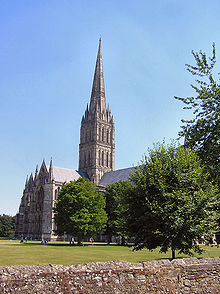 Salisbury Cathedral has the tallest spire in England.
Salisbury Cathedral has the tallest spire in England.
Height
A characteristic of Gothic church architecture is its height, both absolute and in proportion to its width. A section of the main body of a Gothic church usually shows the nave as considerably taller than it is wide. In England the proportion is sometimes greater than 2:1, while the greatest proportional difference achieved is at Cologne Cathedral with a ratio of 3.6:1. The highest internal vault is at Beauvais Cathedral at 48 metres (157 ft).[7]
Externally, towers and spires are characteristic of Gothic churches both great and small, the number and positioning being one of the greatest variables in Gothic architecture. In Italy, the tower, if present, is almost always detached from the building, as at Florence Cathedral, and is often from an earlier structure. In France and Spain, two towers on the front is the norm. In England, Germany and Scandinavia this is often the arrangement, but an English cathedral may also be surmounted by an enormous tower at the crossing. Smaller churches usually have just one tower, but this may also be the case at larger buildings, such as Salisbury Cathedral or Ulm Minster, which has the tallest spire in the world,[18] slightly exceeding that of Lincoln Cathedral, the tallest which was actually completed during the medieval period, at 160 metres (520 ft).
 The Gothic east end of Cologne Cathedral represents the extreme of verticality. (nave, dating to the 19th century).
The Gothic east end of Cologne Cathedral represents the extreme of verticality. (nave, dating to the 19th century).
Vertical emphasis
The pointed arch lends itself to a suggestion of height. This appearance is characteristically further enhanced by both the architectural features and the decoration of the building.[16]
On the exterior, the verticality is emphasised in a major way by the towers and spires and in a lesser way by strongly projecting vertical buttresses, by narrow half-columns called attached shafts which often pass through several storeys of the building, by long narrow windows, vertical mouldings around doors and figurative sculpture which emphasises the vertical and is often attenuated. The roofline, gable ends, buttresses and other parts of the building are often terminated by small pinnacles, Milan Cathedral being an extreme example in the use of this form of decoration.
On the interior of the building attached shafts often sweep unbroken from floor to ceiling and meet the ribs of the vault, like a tall tree spreading into branches. The verticals are generally repeated in the treatment of the windows and wall surfaces. In many Gothic churches, particularly in France, and in the Perpendicular period of English Gothic architecture, the treatment of vertical elements in gallery and window tracery creates a strongly unifying feature that counteracts the horizontal divisions of the interior structure.[16]
Light
One of the most distinctive characteristics of Gothic architecture is the expansive area of the windows as at Sainte Chapelle and the very large size of many individual windows, as at York Minster, Gloucester Cathedral and Milan Cathedral. The increase in size between windows of the Romanesque and Gothic periods is related to the use of the ribbed vault, and in particular, the pointed ribbed vault which channeled the weight to a supporting shaft with less outward thrust than a semicircular vault. Walls did not need to be so weighty.[10][16]
A further development was the flying buttress which arched externally from the springing of the vault across the roof of the aisle to a large buttress pier projecting well beyond the line of the external wall. These piers were often surmounted by a pinnacle or statue, further adding to the downward weight, and counteracting the outward thrust of the vault and buttress arch as well as stress from wind loading.
The internal columns of the arcade with their attached shafts, the ribs of the vault and the flying buttresses, with their associated vertical buttresses jutting at right-angles to the building, created a stone skeleton. Between these parts, the walls and the infill of the vaults could be of lighter construction. Between the narrow buttresses, the walls could be opened up into large windows.[7]
Through the Gothic period, due to the versatility of the pointed arch, the structure of Gothic windows developed from simple openings to immensely rich and decorative sculptural designs. The windows were very often filled with stained glass which added a dimension of colour to the light within the building, as well as providing a medium for figurative and narrative art.[16]
Majesty
The façade of a large church or cathedral, often referred to as the West Front, is generally designed to create a powerful impression on the approaching worshipper, demonstrating both the might of God, and the might of the institution that it represents. One of the best known and most typical of such façades is that of Notre Dame de Paris.
Central to the façade is the main portal, often flanked by additional doors. In the arch of the door, the tympanum, is often a significant piece of sculpture, most frequently Christ in Majesty and Judgment Day. If there is a central door jamb or a tremeau, then it frequently bears a statue of the Madonna and Child. There may be much other carving, often of figures in niches set into the mouldings around the portals, or in sculptural screens extending across the façade.
Above the main portal there is generally a large window, like that at York Minster, or a group of windows such as those at Ripon Cathedral. In France there is generally a rose window like that at Reims Cathedral. Rose windows are also often found in the façades of churches of Spain and Italy, but are rarer elsewhere and are not found on the façades of any English Cathedrals. The gable is usually richly decorated with arcading or sculpture, or in the case of Italy, may be decorated, with the rest of the façade, with polychrome marble and mosaic, as at Orvieto Cathedral.
The West Front of a French cathedral and many English, Spanish and German cathedrals generally has two towers, which, particularly in France, express an enormous diversity of form and decoration.[7][8] However some German cathedrals have only one tower located in the middle of the façade (such as Freiburg Münster).
 The façade of Ripon Cathedral presents a composition in untraceried pointed arches.
The façade of Ripon Cathedral presents a composition in untraceried pointed arches.
Basic shapes of Gothic arches and stylistic character
The way in which the pointed arch was drafted and utilised developed throughout the Gothic period. There were fairly clear stages of development, which did not, however, progress at the same rate, or in the same way in every country. Moreover, the names used to define various periods or styles within the Gothic differs from country to country.
Lancet arch
The simplest shape is the long opening with a pointed arch known in England as the lancet. Lancet openings are often grouped, usually as a cluster of three or five. Lancet openings may be very narrow and steeply pointed.
Salisbury Cathedral is famous for the beauty and simplicity of its Lancet Gothic, known in England as the Early English Style. York Minster has a group of lancet windows each fifty feet high and still containing ancient glass. They are known as the Five Sisters. These simple undecorated grouped windows are found at Chartres and Laon Cathedrals and are used extensively in Italy.[7][9]
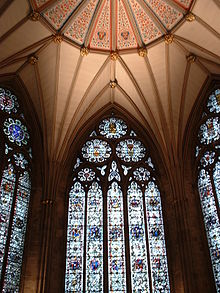 Windows in the Chapter House at York Minster show the equilateral arch with typical circular motifs in the tracery.
Windows in the Chapter House at York Minster show the equilateral arch with typical circular motifs in the tracery.
Equilateral arch
Many Gothic openings are based upon the equilateral form. In other words, when the arch is drafted, the radius is exactly the width of the opening and the centre of each arch coincides with the point from which the opposite arch springs. This makes the arch higher in relation to its width than a semi-circular arch which is exactly half as high as it is wide.[7]
The Equilateral Arch gives a wide opening of satisfying proportion useful for doorways, decorative arcades and large windows.
The structural beauty of the Gothic arch means, however, that no set proportion had to be rigidly maintained. The Equilateral Arch was employed as a useful tool, not as a Principle of Design. This meant that narrower or wider arches were introduced into a building plan wherever necessity dictated. In the architecture of some Italian cities, notably Venice, semi-circular arches are interspersed with pointed ones.[19]
The Equilateral Arch lends itself to filling with tracery of simple equilateral, circular and semi-circular forms. The type of tracery that evolved to fill these spaces is known in England as Geometric Decorated Gothic and can be seen to splendid effect at many English and French Cathedrals, notably Lincoln and Notre Dame in Paris. Windows of complex design and of three or more lights or vertical sections, are often designed by overlapping two or more equilateral arches.[9]
Flamboyant arch
Flamboyant tracery at Limoges Cathedral.
The Flamboyant Arch is one that is drafted from four points, the upper part of each main arc turning upwards into a smaller arc and meeting at a sharp, flame-like point. These arches create a rich and lively effect when used for window tracery and surface decoration. The form is structurally weak and has very rarely been used for large openings except when contained within a larger and more stable arch. It is not employed at all for vaulting.[7]
Some of the most beautiful and famous traceried windows of Europe employ this type of tracery. It can be seen at St Stephen's Vienna, Sainte Chapelle in Paris, at the Cathedrals of Limoges and Rouen in France, and at Milan Cathedral in Italy. In England the most famous examples are the West Window of York Minster with its design based on the Sacred Heart, the extraordinarily rich seven-light East Window at Carlisle Cathedral and the exquisite East window of Selby Abbey.[9][10]
Doorways surmounted by Flamboyant mouldings are very common in both ecclesiastical and domestic architecture in France. They are much rarer in England. A notable example is the doorway to the Chapter Room at Rochester Cathedral.[7][9]
The style was much used in England for wall arcading and niches. Prime examples in are in the Lady Chapel at Ely, the Screen at Lincoln and externally on the façade of Exeter Cathedral. In German and Spanish Gothic architecture it often appears as openwork screens on the exterior of buildings. The style was used to rich and sometimes extraordinary effect in both these countries, notably on the famous pulpit in Vienna Cathedral.[8]
 The depressed arch supported by fan vaulting at King's College Chapel, England.
The depressed arch supported by fan vaulting at King's College Chapel, England.
Depressed arch
The Depressed or four-centred arch is much wider than its height and gives the visual effect of having been flattened under pressure. Its structure is achieved by drafting two arcs which rise steeply from each springing point on a small radius and then turn into two arches with a wide radius and much lower springing point.[7]
This type of arch, when employed as a window opening, lends itself to very wide spaces, provided it is adequately supported by many narrow vertical shafts. These are often further braced by horizontal transoms. The overall effect produces a grid-like appearance of regular, delicate, rectangular forms with an emphasis on the perpendicular. It is also employed as a wall decoration in which arcade and window openings form part of the whole decorative surface.
The style, known as Perpendicular, that evolved from this treatment is specific to England, although very similar to contemporary Spanish style in particular, and was employed to great effect through the 15th century and first half of the 16th as Renaissance styles were much slower to arrive in England than in Italy and France.[7]
It can be seen notably at the East End of Gloucester Cathedral where the East Window is said to be as large as a tennis court. There are three very famous royal chapels and one chapel-like Abbey which show the style at its most elaborate- King's College Chapel, Cambridge; St George's Chapel, Windsor; Henry VII's Chapel at Westminster Abbey and Bath Abbey.[9] However very many simpler buildings, especially churches built during the wool boom in East Anglia, are fine examples of the style.
Symbolism and ornamentation
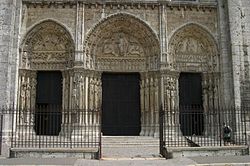 The Royal Portal of Chartres Cathedral.
The Royal Portal of Chartres Cathedral. Main articles: Cathedral architecture of Western Europe and Poor Man's Bible
Main articles: Cathedral architecture of Western Europe and Poor Man's BibleThe Gothic cathedral represented the universe in microcosm and each architectural concept, including the loftiness and huge dimensions of the structure, were intended to convey a theological message: the great glory of God. The building becomes a microcosm in two ways. Firstly, the mathematical and geometrical nature of the construction is an image of the orderly universe, in which an underlying rationality and logic can be perceived.
Secondly, the statues, sculptural decoration, stained glass and murals incorporate the essence of creation in depictions of the Labours of the Months and the Zodiac[20] and sacred history from the Old and New Testaments and Lives of the Saints, as well as reference to the eternal in the Last Judgment and Coronation of the Virgin.
 The Devil tempting the Foolish Virgins at Strasbourg.
The Devil tempting the Foolish Virgins at Strasbourg.
The decorative schemes usually incorporated Biblical stories, emphasizing visual typological allegories between Old Testament prophecy and the New Testament.[8]
Many churches were very richly decorated, both inside and out. Sculpture and architectural details were often bright with coloured paint of which traces remain at the Cathedral of Chartres. Wooden ceilings and panelling were usually brightly coloured. Sometimes the stone columns of the nave were painted, and the panels in decorative wall arcading contained narratives or figures of saints. These have rarely remained intact, but may be seen at the Chapterhouse of Westminster Abbey.[9]
Some important Gothic churches could be severely simple such as the Basilica of Mary Magdalene in Saint-Maximin, Provence where the local traditions of the sober, massive, Romanesque architecture were still strong.
Regional differences
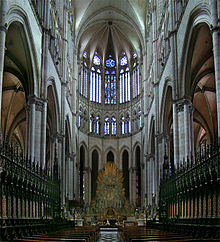 Interior of Amiens Cathedral, France.
Interior of Amiens Cathedral, France. Main article: Architecture of cathedrals and great churches
Main article: Architecture of cathedrals and great churchesWherever Gothic architecture is found, it is subject to local influences, and frequently the influence of itinerant stonemasons and artisans, carrying ideas between cities and sometimes between countries. Certain characteristics are typical of particular regions and often override the style itself, appearing in buildings hundreds of years apart.
France
Main article: French Gothic architectureThe distinctive characteristic of French cathedrals, and those in Germany and Belgium that were strongly influenced by them, is their height and their impression of verticality. Each French cathedral tends to be stylistically unified in appearance when compared with an English cathedral where there is great diversity in almost every building. They are compact, with slight or no projection of the transepts and subsidiary chapels. The west fronts are highly consistent, having three portals surmounted by a rose window, and two large towers. Sometimes there are additional towers on the transept ends. The east end is polygonal with ambulatory and sometimes a chevette of radiating chapels. In the south of France, many of the major churches are without transepts and some are without aisles.[7]
The longitudinal emphasis in the nave of Wells is typically English.
A good example is Toul Cathedral.
England
Main article: English Gothic architectureThe distinctive characteristic of English cathedrals is their extreme length, and their internal emphasis upon the horizontal, which may be emphasised visually as much or more than the vertical lines. Each English cathedral (with the exception of Salisbury) has an extraordinary degree of stylistic diversity, when compared with most French, German and Italian cathedrals. It is not unusual for every part of the building to have been built in a different century and in a different style, with no attempt at creating a stylistic unity. Unlike French cathedrals, English cathedrals sprawl across their sites, with double transepts projecting strongly and Lady Chapels tacked on at a later date. In the west front, the doors are not as significant as in France, the usual congregational entrance being through a side porch. The West window is very large and never a rose, which are reserved for the transept gables. The west front may have two towers like a French Cathedral, or none. There is nearly always a tower at the crossing and it may be very large and surmounted by a spire. The distinctive English east end is square, but it may take a completely different form. Both internally and externally, the stonework is often richly decorated with carvings, particularly the capitals.[7][9]
 The spacious interior of Regensburg Cathedral.
The spacious interior of Regensburg Cathedral.
Germany and the Holy Roman Empire
Romanesque architecture in Germany is characterised by its massive and modular nature. This is expressed in the Gothic architecture of the Holy Roman Empire in the huge size of the towers and spires, often proposed, but not always completed.[21] The west front generally follows the French formula, but the towers are very much taller, and if complete, are surmounted by enormous openwork spires that are a regional feature. Because of the size of the towers, the section of the façade that is between them may appear narrow and compressed. The eastern end follows the French form. The distinctive character of the interior of German Gothic cathedrals is their breadth and openness. This is the case even when, as at Cologne, they have been modelled upon a French cathedral. German cathedrals, like the French, tend not to have strongly projecting transepts. There are also many hall churches (Hallenkirchen) without clerestory windows.[7][16]
Spain and Portugal
Main article: Spanish Gothic architectureMain article: Portuguese Gothic architectureThe distinctive characteristic of Gothic cathedrals of the Iberian Peninsula is their spatial complexity, with many areas of different shapes leading from each other. They are comparatively wide, and often have very tall arcades surmounted by low clerestories, giving a similar spacious appearance to the hallenkirche of Germany, as at the Church of the Batalha Monastery in Portugal. Many of the cathedrals are completely surrounded by chapels. Like English Cathedrals, each is often stylistically diverse. This expresses itself both in the addition of chapels and in the application of decorative details drawn from different sources. Among the influences on both decoration and form are Islamic architecture, and towards the end of the period, Renaissance details combined with the Gothic in a distinctive manner. The West front, as at Leon Cathedral typically resembles a French west front, but wider in proportion to height and often with greater diversity of detail and a combination of intricate ornament with broad plain surfaces. At Burgos Cathedral there are spires of German style. The roofline often has pierced parapets with comparatively few pinnacles. There are often towers and domes of a great variety of shapes and structural invention rising above the roof.[7]
Italy
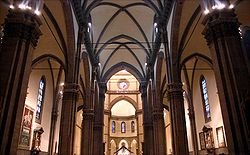 The clear proportions of Florence Cathedral are defined by dark stone against the colour-washed plastered brick.
The clear proportions of Florence Cathedral are defined by dark stone against the colour-washed plastered brick. Main article: Italian Gothic architecture
Main article: Italian Gothic architectureThe distinctive characteristic of Italian Gothic is the use of polychrome decoration, both externally as marble veneer on the brick façade and also internally where the arches are often made of alternating black and white segments, and where the columns may be painted red, the walls decorated with frescoes and the apse with mosaic. The plan is usually regular and symmetrical. With the exception of Milan Cathedral which is Germanic in style, Italian cathedrals have few and widely spaced columns. The proportions are generally mathematically equilibrated, based on the square and the concept of "armonìa", and except in Venice where they loved flamboyant arches, the arches are almost always equilateral. Colours and moldings define the architectural units rather than blending them. Italian cathedral façades are often polychrome and may include mosaics in the lunettes over the doors. The façades have projecting open porches and occular or wheel windows rather than roses, and do not usually have a tower. The crossing is usually surmounted by a dome. There is often a free-standing tower and baptistry. The eastern end usually has an apse of comparatively low projection. The windows are not as large as in northern Europe and, although stained glass windows are often found, the favourite narrative medium for the interior is the fresco.[7]
Other Gothic buildings
- See also Castle
 The façade of the Palais des Papes
The façade of the Palais des Papes
Synagogues, commonly built in the prevailing architectural style of the period and country where they are constructed, were built in the Gothic style in Europe during the Medieval period. A surviving example is the Old New Synagogue in Prague, built in the 13th century. Many examples of secular, non-military structures in Gothic style survive in fairly original condition. The Palais des Papes in Avignon is the best complete large royal palace, with partial survivals in the great hall at the Palace of Westminster, London, an 11th-century hall renovated in the late 14th century with gothic windows and a wooden hammerbeam roof, and the famous Conciergerie, former palace of the kings of France, in Paris. In addition to monumental secular architecture, examples of the Gothic style can be seen in surviving medieval portions of cities across Europe, above all the distinctive Venetian Gothic such as the Ca' d'Oro. The house of the wealthy early 15th century merchant Jacques Coeur in Bourges, is the classic Gothic bourgeois mansion, full of the asymmetry and complicated detail beloved of the Gothic Revival.[22]
Other cities with a concentration of secular Gothic include Bruges and Siena. Most surviving small secular buildings are relatively plain and straightforward; most windows are flat-topped with mullions, with pointed arches and vaulted ceilings often only found at a few focal points. The country-houses of the nobility were slow to abandon the appearance of being a castle, even in parts of Europe, like England, where defence had ceased to be a real concern. The living and working parts of many monastic buildings survive, for example at Mont Saint-Michel.
There are many excellent examples of secular Brick Gothic structures scattered throughout Poland and the Baltic States, most notably Malbork Castle, the Gdańsk Town Hall, and Collegium Maius in Krakow.
Exceptional works of Gothic architecture can also found in Cyprus, especially in the walled cities of Nicosia and Famagusta. Also, the roof of the Znojmo Town Hall Tower in the Czech Republic is an excellent example of late Gothic craftsmanship.
Gothic survival and revival
 Chateau d'Abbadie, Hendaye, France: a Gothic pile for the natural historian and patron of astronomy Antoine d'Abbadie, 1860–1870; Viollet-le-Duc, architect
Chateau d'Abbadie, Hendaye, France: a Gothic pile for the natural historian and patron of astronomy Antoine d'Abbadie, 1860–1870; Viollet-le-Duc, architect Main article: Gothic revival architecture
Main article: Gothic revival architectureIn 1663 at the Archbishop of Canterbury's residence, Lambeth Palace, a Gothic hammerbeam roof was built to replace that destroyed when the building was sacked during the English Civil War. Also in the late 17th century, some discrete Gothic details appeared on new construction at Oxford and Cambridge, notably on Tom Tower at Christ Church, Oxford, by Christopher Wren. It is not easy to decide whether these instances were Gothic survival or early appearances of Gothic revival.
In England in the mid-18th century, the Gothic style was more widely revived, first as a decorative, whimsical alternative to Rococo that is still conventionally termed 'Gothick', of which Horace Walpole's Twickenham villa "Strawberry Hill" is the familiar example.
19th and 20th century Gothic Revival
Main article: Gothic RevivalIn England, partly in response to a philosophy propounded by the Oxford Movement and others associated with the emerging revival of 'high church' or Anglo-Catholic ideas during the second quarter of the 19th century, neo-Gothic began to become promoted by influential establishment figures as the preferred style for ecclesiastical, civic and institutional architecture. The appeal of this Gothic revival (which after 1837, in Britain, is sometimes termed Victorian Gothic), gradually widened to encompass "low church" as well as "high church" clients. This period of more universal appeal, spanning 1855–1885, is known in Britain as High Victorian Gothic.
The Houses of Parliament in London by Sir Charles Barry with interiors by a major exponent of the early Gothic Revival, Augustus Welby Pugin, is an example of the Gothic revival style from its earlier period in the second quarter of the 19th century. Examples from the High Victorian Gothic period include George Gilbert Scott's design for the Albert Memorial in London, and William Butterfield's chapel at Keble College, Oxford. From the second half of the 19th century onwards it became more common in Britain for neo-Gothic to be used in the design of non-ecclesiastical and non-governmental buildings types. Gothic details even began to appear in working-class housing schemes subsidised by philanthropy, though due to the expense, less frequently than in the design of upper and middle-class housing.
In France, simultaneously, the towering figure of the Gothic Revival was Eugène Viollet-le-Duc, who outdid historical Gothic constructions to create a Gothic as it ought to have been, notably at the fortified city of Carcassonne in the south of France and in some richly fortified keeps for industrial magnates. Viollet-le-Duc compiled and coordinated an Encyclopédie médiévale that was a rich repertory his contemporaries mined for architectural details. He effected vigorous restoration of crumbling detail of French cathedrals, including the Abbey of Saint-Denis and famously at Notre Dame, where many of whose most "Gothic" gargoyles are Viollet-le-Duc's. He taught a generation of reform-Gothic designers and showed how to apply Gothic style to modern structural materials, especially cast iron.
In Germany, the great cathedral of Cologne and the Ulm Minster, left unfinished for 600 years, were brought to completion, while in Italy, Florence Cathedral finally received its polychrome Gothic façade. New churches in the Gothic style were created all over the world, including Mexico, Argentina, Japan, Thailand, India, Australia, New Zealand, Hawaii and South Africa.
As in Europe, the United States, Canada, Australia and New Zealand utilised Neo-Gothic for the building of universities, a fine example being Sydney University by Edmund Blacket. In Canada, the Canadian Parliament Buildings in Ottawa designed by Thomas Fuller and Chilion Jones with its huge centrally placed tower draws influence from Flemish Gothic buildings.
Although falling out of favour for domestic and civic use, Gothic for churches and universities continued into the 20th century with buildings such as Liverpool Cathedral, the Cathedral of Saint John the Divine, New York and São Paulo Cathedral, Brazil. The Gothic style was also applied to iron-framed city skyscapers such as Cass Gilbert's Woolworth Building and Raymond Hood's Tribune Tower.
Post-Modernism in the late 20th and early 21st centuries has seen some revival of Gothic forms in individual buildings, such as the Gare do Oriente in Lisbon, Portugal and a finishing of the Cathedral of Our Lady of Guadalupe in Mexico.
See also
About medieval Gothic in particular
 The Basilica of Mary Magdalene, Saint Maximin la Sainte Baume, Provence, begun in 1295, building work continued for more than 100 years, maintaining the 13th century style.
The Basilica of Mary Magdalene, Saint Maximin la Sainte Baume, Provence, begun in 1295, building work continued for more than 100 years, maintaining the 13th century style.
- Castle
- English Gothic architecture
- French Gothic architecture
- Italian Gothic architecture
- List of Gothic architecture
- Medieval architecture
- Middle Ages in history
- Polish Gothic architecture
- Portuguese Gothic architecture
- Renaissance of the 12th century
- Spanish Gothic architecture
About Gothic architecture more generally or in other senses
- Architectural history
- Architectural style
- Architecture of cathedrals and great churches
- Sondergotik
- Gothicmed
- Gothic Revival
- Carpenter Gothic
- Collegiate Gothic in North America
- Tented roof
Notes
The flattened surface of this vault is supported by a multitude of decorative ribs called tierceron vaulting.
- ^ Banister Fletcher quotes Vasari as using this term.
- ^ "Gotz" is rendered as "Huns" in Thomas Urquhart's English translation.
- ^ Notes and Queries, No. 9. 29 December 1849
- ^ Christopher Wren, 17th-century architect of St. Paul's Cathedral.
- ^ "pour terminer le haut de leurs ouvertures. La Compagnie a désapprové plusieurs de ces nouvelles manières, qui sont défectueuses et qui tiennent la plupart du gothique." Quoted in Fiske Kimball, The Creation of the Rococo, 1943, p 66.
- ^ a b "L'art Gothique", section: "L'architecture Gothique en Angleterre" by Ute Engel: L'Angleterre fut l'une des premieres régions à adopter, dans la deuxième moitié du XIIeme siècle, la nouvelle architecture gothique née en France. Les relations historiques entre les deux pays jouèrent un rôle prépondérant: en 1154, Henri II (1154–1189), de la dynastie Française des Plantagenêt, accéda au thrône d'Angleterre." (England was one of the first regions to adopt, during the first half of the 12th century, the new gothic architecture born in France. Historic relationships between the two countries played a determining role: in 1154, Henry II (1154–1189), of the French Plantagenet dynasty, ascended to the throne of England).
- ^ a b c d e f g h i j k l m n o p q r s t u v w Banister Fletcher, A History of Architecture on the Comparative Method.
- ^ a b c d e f John Harvey, The Gothic World
- ^ a b c d e f g h i Alec Clifton-Taylor, The Cathedrals of England
- ^ a b c d e Nikolaus Pevsner, An Outline of European Architecture.
- ^ Leick, Gwendoly: A Dictionary of Ancient Near Eastern Architecture, "Vault", London 2003, pp. 238–240 ISBN 0-203-04107-0
- ^ Warren, John (1991). "Creswell's Use of the Theory of Dating by the Acuteness of the Pointed Arches in Early Muslim Architecture". Muqarnas (BRILL) 8: 59–65 (61–63). doi:10.2307/1523154. JSTOR 1523154.
- ^ a b Scott, Robert A.: The Gothic enterprise: a guide to understanding the Medieval cathedral, Berkeley 2003, University of California Press, p. 113 ISBN 0-520-23177-5
- ^ Cf. Bony (1983), especially p.17
- ^ Erwin Panofsky argued that Suger was inspired to create a physical representation of the Heavenly Jerusalem, however the extent to which Suger had any aims higher than aesthetic pleasure has been called into doubt by more recent art historians on the basis of Suger's own writings.
- ^ a b c d e f g h Wim Swaan, The Gothic Cathedral
- ^ *Warren, John (1991). "Creswell's Use of the Theory of Dating by the Acuteness of the Pointed Arches in Early Muslim Architecture". Muqarnas (BRILL) 8: 59–65. doi:10.2307/1523154. JSTOR 1523154.
- ^ The open-work spire was completed in 1890 to the original design.
- ^ This does not happen in French or English Gothic and so to the British or French eye, to be a strange disregard for style.
- ^ The Zodiac comprises a sequence of twelve constellations which appear overhead in the Northern Hemisphere at fixed times of year. In a rural community with neither clock nor calendar, these signs in the heavens were crucial in knowing when crops were to be planted and certain rural activities performed.
- ^ Freiburg, Regensburg, Strasbourg, Vienna, Ulm, Cologne, Antwerp.
- ^ Begun in 1443. "House of Jacques Cœur at Bourges (Begun 1443), aerial sketch". Liam’s Pictures from Old Books. http://www.fromoldbooks.org/Smith-GothicArchitecture/pages/015-07-House-of-Jacques-Coeur-at-Bourges. Retrieved 29 September 2007.
References
- Bony, Jean (1983). French Gothic Architecture of the Twelfth and Thirteenth Centuries. Berkeley: University of California Press. ISBN 0520028317. http://books.google.com/books?id=k7ytJ-gXonMC&printsec=frontcover.
- Bumpus, T. Francis (1928). The Cathedrals and Churches of Belgium. T. Werner Laurie.
- Clifton-Taylor, Alec (1967). The Cathedrals of England. Thames and Hudson. ISBN 0500180709.
- Fletcher, Banister (2001). A History of Architecture on the Comparative method. Elsevier Science & Technology. ISBN 0-7506-2267-9.
- Gardner, Helen; Fred S. Kleiner, Christin J. Mamiya (2004). Gardner's Art through the Ages. Thomson Wadsworth. ISBN 0-15-505090-7.
- Harvey, John (1950). The Gothic World, 1100–1600. Batsford.
- Harvey, John (1961). English Cathedrals. Batsford.
- Huyghe, Rene (ed.) (1963). Larousse Encyclopedia of Byzantine and Medieval Art. Paul Hamlyn.
- Icher, Francois (1998). Building the Great Cathedrals. Harry N. Abrams. ISBN 0-8109-4017-5.
- Pevsner, Nikolaus (1964). An Outline of European Architecture. Pelican Books. ISBN 0140616136.
- Summerson, John (1983). Pelican History of Art. ed. Architecture in Britain, 1530–1830. ISBN 0-14-0560-03-3.
- Swaan, Wim (1988). The Gothic Cathedral. Omega Books. ISBN 0-9078593-48-X.
- Swaan, Wim. Art and Architecture of the Late Middle Ages. Omega Books. ISBN 0-907853-35-8.
- Tatton-Brown, Tim; John Crook (2002). The English Cathedral. New Holland Publishers. ISBN 1-84330-120-2.
Further reading
- Fletcher, Banister; Cruickshank, Dan, Sir Banister Fletcher's a History of Architecture, Architectural Press, 20th edition, 1996 (first published 1896). ISBN 0750622679. Cf. Part Two, Chapter 14.
- von Simson, Otto Georg (1988). The Gothic cathedral: origins of Gothic architecture and the medieval concept of order. ISBN 0-691-09959-6.
- Glaser, Stephanie, "The Gothic Cathedral and Medievalism," in: Falling into Medievalism, ed. Anne Lair and Richard Utz. Special Issue of UNIversitas: The University of Northern Iowa Journal of Research, Scholarship, and Creative Activity, 2.1 (2006). (on the Gothic revival of the 19th century and the depictions of Gothic cathedrals in the Arts)
- Moore, Charles (1890). Development & Character of Gothic Architecture. Macmillan and Co.. ISBN 1410207633.
- Tonazzi, Pascal (2007) Florilège de Notre-Dame de Paris (anthologie), Editions Arléa, Paris, ISBN 257895462
External links
- Holbeche Bloxam, Matthew (1841). Gothic Ecclesiastical Architecture, Elucidated by Question and Answer. Gutenberg.org, from Project Gutenberg
- Brandon, Raphael; Brandon, Arthur (1849). An analysis of Gothick architecture: illustrated by a series of upwards of seven hundred examples of doorways, windows, etc., and accompanied with remarks on the several details of an ecclesiastical edifice., Archive.org, from Internet Archive
Gothic Ancient Late medieval Gothic architecture – Gothic art – Gothic scriptRomanticism Modern Literature and Art Other History of architecture Neolithic · Ancient Egyptian · Coptic · Chinese · Dravidian · Mayan · Mesopotamian · Classical · Mesoamerican · Achaemenid Persia · Ancient Greek · Roman · Incan · Sassanid · Byzantine · Islamic · Newari · Buddhist · Somali · Persian · Pre-Romanesque · Romanesque · Romano-Gothic · Gothic · Plateresque · Manueline · Hoysala · Vijayanagara · Western Chalukya · Renaissance · Ottoman · Mughal · Baroque · Biedermeier · Classicism · Neoclassical · Historicism · Gründerzeit · Gothic Revival · Neo-Renaissance · Neo-Baroque · Rationalism · Modernisme · Art Nouveau · Expressionism · Modern · PostmodernCategories:- Gothic architecture
- Architectural styles
- Roman Catholic Church architecture
- Italian architecture
- Medieval French architecture
- English architecture
Wikimedia Foundation. 2010.




